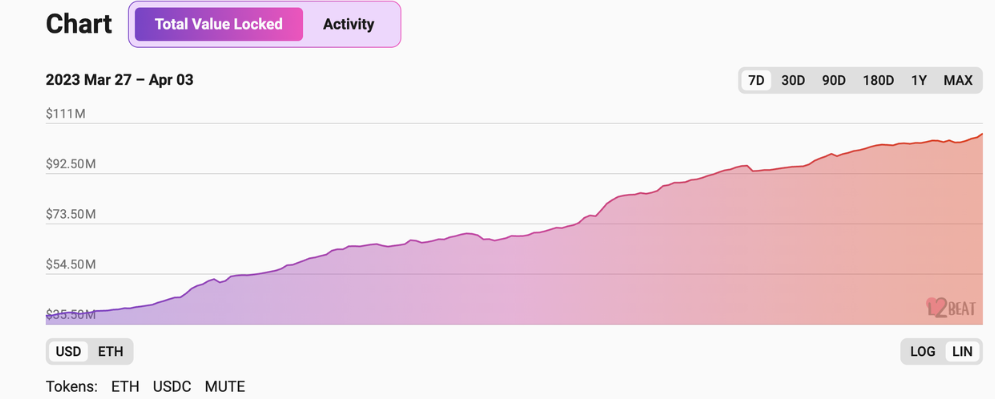What will the competitive landscape between Zk Rollup and Op Rollup look like in the future?
Written by: Yuzhong Kuangshui
After the rise of Optimistic Rollup, Zk Rollup is迎来属于它的春天.
At a suitable opportunity after the $ARB airdrop ended, Zksync announced the launch of the Era mainnet, followed by a rapid increase in its TVL (Total Value Locked). According to L2BEAT data, as of April 2, the TVL of the Era mainnet has exceeded $100 million.
Another important event for Zk is that Polygon officially launched the beta version of the zkEVM mainnet, with Ethereum co-founder Vitalik Buterin conducting a symbolic first transaction.

From the perspective of airdrop hunters, the substantial rewards from previous Layer 2 airdrops are attracting this group to widely enter the Zk Rollup ecosystem and participate in ecological protocols.
From the perspective of narrative hotspots, the release of the Optimism Rollup airdrop signifies a short-term cooling of its narrative, and the market will focus on newer hotspots—namely, the new Zk products launched in this opportunity.
Regardless, the overall cryptocurrency market is optimistic about ZKP technology and Layer 2 trends.
The advantages of Rollups using ZKP technology compared to Optimism Rollups are:
Faster speed and higher security: Optimism Rollups, which use fraud proofs, require trust assumptions and rely on honest nodes to verify the reliability of transactions; whereas Zk Rollups only need to provide validity proofs to verify transaction reliability.
Higher privacy: With ZKP technology, Zk Rollups only need to ensure off-chain integrity, allowing provers to prove the validity of transaction batches without revealing specific transaction details, nor requiring verifiers to check all transactions before accepting the new state.
However, due to EVM's lack of support for ZK circuits, the large-scale adoption of Zk Rollups seems challenging. Therefore, to lower the entry barrier for Zk Rollup developers, zkEVM has become a prominent focus in the Zk Rollup track. The inherent logic of zkEVM is that Zk Rollup solutions provide developers with a deployment environment that has EVM equivalence, and then convert the code to a virtual machine environment compatible with ZK circuits to achieve validity proofs supported by ZKP technology.
Concerns
However, as the market welcomes the ZK wave, Zk Rollups will also face new challenges:
Polygon zkEVM
When packaging transactions to send to Layer 1, it essentially involves a group of traders crowdfunding to lower costs. When the number of traders is large, the shared costs naturally do not put too much pressure on Polygon.
However, when the number of traders is small, costs cannot be shared, and Polygon will need to subsidize. This means that if Polygon zkEVM does not have enough users, it will need to continue subsidizing, putting immense financial pressure on the officials.
Zksync Era
After a large influx of liquidity, Zksync gained a significant number of users. Under this pressure, the zkSync Era mainnet experienced downtime, with the block production pause lasting about 4 hours.
According to the team's post-event analysis, the reason was a failure in the block queue database, which halted block production.
To prevent similar situations from occurring again, Zksync assigned another layer of identity to its database monitoring agent, which can help it continue working when issues arise in the database.
In fact, the problems faced by Polygon zkEVM and Zksync Era are fundamentally the same; they are both dealing with user and block sorting issues.
On Layer 1, block sorting is under the distribution of interests, and MEV has become a universal solution under sorting games.
Meanwhile, the development of MEV technology on Layer 2 is still up for discussion.
Encrypted mempools may be a good application direction for MEV—using ZKP technology to encrypt and decrypt user transactions while avoiding scrutiny from centralized institutions. Encrypted mempools ultimately ensure fair execution of sorting.
A New Vitality for Optimism Rollup
At the same time, we cannot overlook the strong vitality of Optimism.
Optimism has launched OP Stack—a modular blockchain component that allows developers to build various highly scalable and interoperable blockchains on its foundation. Currently, Coinbase has launched a Layer 2 built on OP Stack. Additionally, the voting for the new upgrade Bedrock will end on April 5.
After Bedrock, Optimism will experience a qualitative leap:
For developers: Better EVM compatibility, allowing developers to migrate their DApps to Optimism with minimal code changes. This alleviates the long-standing issue Optimism has faced—the deployment barrier for developers.
For users: Faster deposit times from Layer 1 to Layer 2 and lower costs for submitting data to Layer 1. The upgrade also introduces a new interactive fraud proof system, Cannon, to achieve lower costs.
For sorters: Allows external teams to build a multi-client ecosystem and introduce incentives to achieve decentralization and reduce single-point risks in the network.
For the ecosystem: Introduces diverse alternative proof systems, including ZKP technology, no longer limited to fraud proofs.
Although Arbitrum is currently caught in a public relations storm, the fundamental reason for its current situation is that it did not clearly explain its early work. Even so, we cannot overlook the brand power and influence that the Arbitrum ecosystem possesses.
Currently, the Arbitrum ecosystem has over 262 protocols, with some of the most innovative DeFi projects built on this ecosystem. According to TokenTerminal data, its 30-day average daily active users are 164,000. Arbitrum's outlook for 2023 mentions that this year, Arbitrum will focus on reducing costs, increasing TPS, and decentralizing validators/sorters/DAOs.
On the market side, Arbitrum will restart the Odyssey campaign and is committed to promoting the adoption of the Nova chain in social applications and gaming applications.
Conclusion
If we look at the competition among various Layer 2s, ZK Rollup has always been a prominent topic in crypto, but it has only recently gained massive attention. Currently, the operational strategy of Zk Rollup is basically to attract more user participation and developer adoption by launching new testnets/mainnets.
Optimism has fallen behind in the competition with Arbitrum, so it needs to quickly launch more advantageous products to attract market attention.
Arbitrum focuses more on market-side work; it is currently the temporary winner in the Layer 2 war, so it needs to promote rich market activities to enhance its brand influence.
Overall, the competitive points between Optimism Rollup and Zk Rollup in product architecture lie in EVM equivalence, speed, and cost. Currently, Optimism Rollup holds a clear advantage in this regard.
As Steven Goldfeder, co-founder of Arbitrum's development team Offchain Labs, mentioned, he disagrees with the widely accepted notion that "ZK Rollup can better replace Optimistic Rollup." Currently, it has not yet been realized in a production environment, and zk-Rollup is more expensive and less compatible than op-Rollup at this stage.
Meanwhile, personnel from the ZK technology camp believe that Zk Rollup can provide equivalent security and higher capital efficiency (no need to wait for challenge periods), and that Optimism Rollup is limited by fraud proofs, which must be executed on Ethereum, while Zk Rollup does not have this restriction.
So, we can't help but wonder whether Zk Rollup's intensive voice this year will have the opportunity to challenge Optimism Rollup's market share?
The answer is affirmative.
However, as Steven Goldfeder said, "Although many teams are steadily advancing zkEVM, it is far from the 'golden age.' Any team pushing this narrative is harming the community."
Pushing for the adoption of Zk Rollup blindly before zkEVM reaches its golden age is a depletion of the ZK narrative.
We cannot currently predict the accurate development of any project based on the superiority of technology. Each Rollup project is driving its product's market share in Layer 2 competition through its unique understanding of crypto technology and the crypto market. As mentioned above, due to the different positions of each project, their product strategies and market strategies will also differ. However, one thing is certain: Ethereum will be the ultimate winner.










